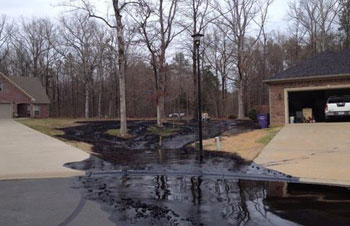Adding insult to injury, and beyond comprehension, companies involved in shipping tar sands oil don’t even have to pay for much of the cleanup.
Although people can smell oil five miles from the spill in Arkansas, it’s really not oil at all according to a 1980 law.
Under that law, tar sands oil is not classified as oil. Because of that, companies that transport it don’t have to pay into the federal Oil Spill Liability Trust Fund, which funds cleanups from spills.
Funny, because tar sands producers like to tell us their oil is just like regular oil! The 1980 law also excludes other "unconventional" oil, such as shale and liquids from coal – an exemption valued at about $35 million a year.

Those that produce and transport crude oil pay 8 cents per barrel into the fund. That money was used to clean up 364 pipeline oil spills last year alone – 54,000 barrels.
The Fund is there to assure quick initial cleanups and to pay costs and claims throughout a disaster response.
It’s also helping to pay for Enbridge’s spill in the Kalamazoo River, even though the company didn’t pay into the fund. Out of $809 million paid for cleanup so far, Enbridge and its insurance company have paid $765 million – the remainder came from the Trust Fund, according to InsideClimate News.
Clearly, who pays into the Oil Spill Fund need to be updated. When bitumen was excluded all those years ago, no tar sands or shale oil was being produced.
Over the past five years, US refiners have bought 30% more oil from Alberta’s tar sands because it’s cheaper than importing oil from OPEC, reports Reuters.
Last year, the US imported 8.5 million barrels a day of oil, down from over 10 million in 2007. Tar sands oil from Canada supplied 2.4 million barrels a day of that, rising from 1.9 million during that time, according to the U.S. Energy Information Administration.
Refiners in the Midwest have spent billions of dollars tweaking their plants so they can process more heavy tar sands oil. Since the pipelines are at capacity, they are also shipping via rail, one of the main reasons Canada wants the Keystone pipeline to be built so badly.
And the pipelines they are shipping tar sands through were not built to withstand this oil, which is much more dense and filled with corrosive chemicals. Even worse, many of pipelines have reached the end of their life and need to be replaced altogether. The pipeline that burst in Arkansas is over 60 years old.
"Tar sands pipelines like the one spilling in Arkansas and the proposed Keystone XL are the definition of a lose-lose situation- we get stuck with toxic spills in our communities and extreme weather from the climate change it causes, but get little of the gasoline destined for foreign markets. In light of yet another spill, it’s time for President Obama to say no to the Keystone XL pipeline once and for all," says Oil Change International in an appropriately titled article, Toxic and Tax Exempt.
Canada’s goal is to export 4.7 million barrels a day by 2020, but it can only do that if new pipelines are built – Keystone, the Northern Gateway to the Pacific coast and an eastern pipeline to the Atlantic coast.
Learn more:

